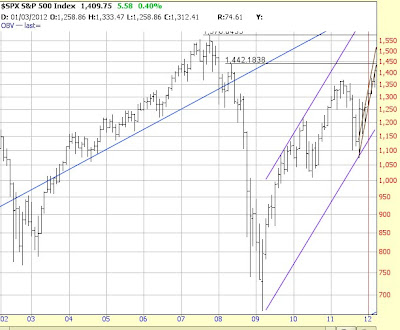Technical
The indices (DJIA 13239, S&P 1409) continued their relentless move up. The Dow closed within its short term up trend (13097-14819). I have been mischaracterizing this as an intermediate term up trend; it is not. The intermediate term up trend in 11295-15201.

At the close yesterday, the S&P confirmed the break above the upper boundary of its intermediate term trading range and re-set to an intermediate term up trend (1157-1650). It is also in a short term up trend (1354-1494).

Volume fell; breadth was mixed. The VIX rose but remained below the lower boundary of its intermediate term trading range for the second day.
GLD rose fractionally and closed right now the upper boundary of its short term down trend.
http://blog.stocktradersalmanac.com/post/Golds-Spring-Rally-GLD
Bottom line: the S&P has re-set to intermediate term and short term up trends as well as returned to directional harmony with the Dow. GLD is challenging its short term down trend.
Update on ‘the best stock market indicator ever’ (short):
http://advisorperspectives.com/dshort/guest/John-Carlucci-Best-Indicator-Ever-Update.php
Fundamental
Headlines
Stocks were the headline yesterday with everyone focused on a Market that can’t go down because of a seemingly unending stream of positive developments: an economy that will continue to pick steam, forgetting high oil prices, rising interest rates and a combo of higher taxes and spending cuts effective 1/1/13; Europe which has apparently resolved its fiscal problems; and a calm Middle East where emotions are always held in check.
http://advisorperspectives.com/commentaries/pimco_31912.php
Bottom line: with the S&P confirming a new up trend, I am now wrong on a number of accounts: (1) I thought that the upper boundary of the Averages intermediate term trading range would hold at least over the short term, (2) our internal indicator is not signaling a robust market--which is the second time since the Market bottomed in 2009 that it has been a laggard, (3) and, of course, fundamentally, where the indices are over their 2012 Year End Fair Value.
Not that I haven’t been wrong before or won’t ever again. But it is important not to sit around and whine about it. For me the most valuable attribute an investor can have is a willingness to admit mistakes and move on; and so that is what I must do--but carefully.
I said in last weekends Closing Bell, one thing that I wanted to do was take advantage of this Market strength to get rid lower quality positions, even though they still qualify for inclusion in our Universe. Accordingly, at the open this morning, the Dividend Growth Portfolio is Selling UGI Corp (UGI-$28) and the High Yield Portfolio is Selling Energy Transfer Ptrs (ETP-$48).
Second, our Portfolios will purchase shares of those stocks on their Buy Lists in which they don’t own a full position. Therefore, the High Yield Portfolio will Buy a full position in TC Pipeline Ptrs (TCP-$45) and the Aggressive Growth Portfolio will take its holding of Balchem (BCPC-$29) back to a full position.
Finally, while nothing has occurred that prompts me to alter either of our Models, because our Portfolios’ high cash position has gotten so high, I think it prudent to hedge this conservative liquidity position but to place the funds in an easily tradable asset that while increasing equity exposure provides a quick exit when, as and if this rally rolls over. Each Portfolio will Buy sufficient shares of the Vanguard Dividend Appreciation ETF (VIG-$59) to take cash down to the 27-28% level. Any decline in stocks (assuming they hold their short term up trend) they will use to move to a 20-25% cash position.
The latest from Fusion IQ (medium):
http://www.ritholtz.com/blog/2012/03/u-s-equity-market-chart-book/
The latest from David Rosenberg (medium):
http://www.zerohedge.com/news/time-its-different-david-rosenberg-explains-melt-and-latent-risks
Steve Cook received his education in investments from Harvard, where he earned an MBA, New York University, where he did post graduate work in economics and financial analysis and the CFA Institute, where he earned the Chartered Financial Analysts designation in 1973. His 40 years of investment experience includes institutional portfolio management at Scudder, Stevens and Clark and Bear Stearns. Steve's goal at Strategic Stock Investments is to help other investors build wealth and benefit from the investing lessons he learned the hard way.

No comments:
Post a Comment